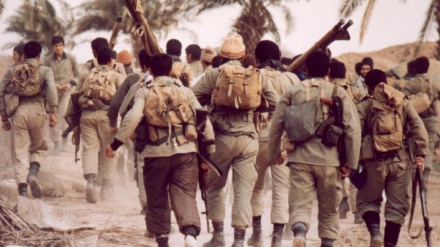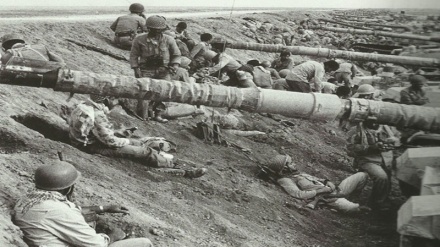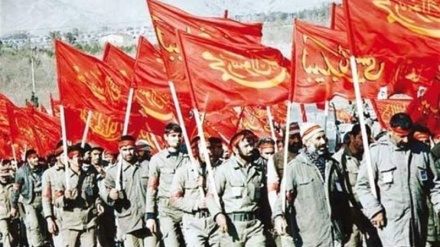Glimpses of Epic of 8-Year Holy Defense (7)
The 1980s was the decade of major developments in the history of Islamic Iran. In late 1970s, the Islamic Revolution gained victory and in late 1980s the 8-year war imposed by the US through the Ba'athist regime of Saddam ended.
This war was a symbol of resistance, epic and sacrifice of the Iranian people from all walks of life and every stratum. This was manifested especially by the youths who stiffly repelled aggression and defended the Islamic Revolution and Iran. Thus this epic was imprinted in the hearts and minds of the Iranian people forever. The initial days and months of the aggression of the Ba'athist regime on the Islamic Republic of Iran have gained lasting fame in the history of the Iranian people which is full of epics. Many cities and villages in the south and west of Iran were occupied by Saddam's army. Invasion of Iran started only 19 months after the victory of the Islamic Revolution, while the Iranian army was not prepared to push back the aggression. Meanwhile, all the strata of the Iranian people came to the assistance of the troops to confront the invasion of the Ba'athist regime of Saddam. The southern port city of Khorramshahr was one of the cities where the popular resistance especially among the youths, against Saddam's armed-to-the-teeth troops has remained indelibly in the history of the holy defense. During the fall of Khorramshahr, after 34 days of epic resistance in 1980 and liberation of the city on May 24, 1982, one of the most beautiful chapters of epic and bravery of Iranian youths in defending the revolution and Iran was demonstrated. For this reason, the day of liberation of Khorramshahr city is called the day of and Resistance and Victory in the Iranian calendar.
The resistance of the defenders of Khorramshahr with the least military equipment stopped the Iraqi army behind the city’s gates. The Iraqi regime’s army thought that it could occupy Khuzestan province within three days. Saddam's commanders sought to tighten the siege of Khorramshahr to crush the resistance of defenders of Khorramshahr. Resistance inside Khorramshahr brought massive casualties for the Iraqi forces and slowed down their advance. However, the lack of support for Khorramshahr defenders and no backup fire caused the enemy to cross Karun River and complete the siege around Khorramshahr without any strikes from the Iranian armed forces. The enemy forces through advancing through Khorramshahr and penetrating into streets got close to the city’s mosque. The center of the city was exposed to the enemy’s attack. Until then all issues were resolved in Khorramshahr mosque. Preparation, organization, mobilization resting of forces and treatment of the injured were done in this mosque. In fact, Khorramshahr's Jame' mosque was the headquarters of operation and command and the center for spiritual nutrition and provision of weapons for the city’s defenders. With the arrival of Iraqi forces in Khorramshahr, the city’s defenders faced with many hardships. The forces inside the city not only did not increase, but gradually they decreased with martyrdom and injuries of the existing forces. Although in this situation, continuation of resistance was difficult, leaving the city seemed more difficult for those who created epic scenes. Thus, the step by step resistance of the Muslim youth lasted until October 16, when Khorramshahr was dubbed as Khuninshahr or “bloody city". The news coming from the city all indicated critical situation and the imminent collapse of Khorramshahr.
Defenders of Khorramshahr fought the enemy till the last drop of their blood while they displayed a revolutionary and at the same time tragic epic through their resistance. The Ba'athist enemy who had earlier considered the occupation of Khorramshahr a very simple and accessible job, and assigned only two battalions to carry out the mission, was forced to use more than two divisions to confront the brave and selfless defenders of Khorramshahr. An Iraqi commander, analyzing the failure of the Iraqi army underlined their lack of access to correct information on popular resistance and said: "If the commanding headquarters wanted to make a decision for attacking Iran, it was necessary to bring very accurate information to the attacking units, as the information given was not correct about possible resistance.” The commander of one of the enemy units in Khorramshahr said: "The information given to our brigade was verbal and swift. In short, Khorramshahr has a very small force with a very strong morale and execution of the mission will take only a few hours."
Alex Afney, the Associated Press reporter, wrote about the epic days in Khorramshahr: Iranian defenders, in October 1980 showed such a firm resistance that after the fall of the city; Iran changed the name of Khorramshahr to blood city. In Khorramshahr you can hardly find a house without mortar or bullet damage on its walls. This indicates how the Iranians defended the city house by house. At that time, a senior Iraqi commander acknowledged that the Iranians who are often young and inexperienced resisted and defended the city till the last drop of their blood.
What was eye-popping was the presence of determined girls among defending groups in Khorramshahr. They, along with men, managed to hold several Iraqi army’s battalions and armored brigades behind the gates of Khorramshahr for 34 days. Saddam’s army arrived in Khorramshahr when the youths of the city had defended the city with the last bullet and achieved martyrdom. The 34-day defense story of Khorramshahr is one of the brilliant pages in the history of the 8-year war imposed by US through its puppet Saddam on Iran. Many valuable books and novels have been published about the 34-day resistance of youths in Khorramshahr. Several movies have been produced on the basis of these novels. The 34-day resistance of Khorramshahr youths against the invasion of Saddam's army is a symbol of steadfastness of the Iranian people. The steadfastness of the defenders of Khorramshahr against the Ba'athist regime’s invasion disrupted the illusions of the Iraqi dictator of invading and disintegrating the territory of the Islamic Republic of Iran.
FK/RM/ME


